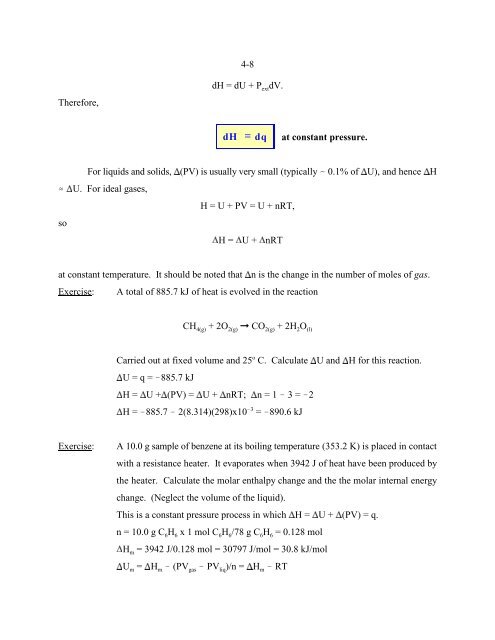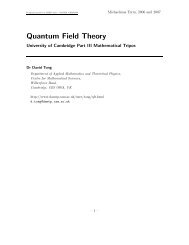CHAPTER 4. THERMODYNAMICS: THE FIRST LAW
CHAPTER 4. THERMODYNAMICS: THE FIRST LAW
CHAPTER 4. THERMODYNAMICS: THE FIRST LAW
You also want an ePaper? Increase the reach of your titles
YUMPU automatically turns print PDFs into web optimized ePapers that Google loves.
4-8<br />
Therefore,<br />
dH = dU + P dV. ext<br />
at constant pressure.<br />
For liquids and solids, (PV) is usually very small (typically - 0.1% of U), and hence H<br />
. U. For ideal gases,<br />
H = U + PV = U + nRT,<br />
so<br />
H = U + nRT<br />
at constant temperature. It should be noted that n is the change in the number of moles of gas.<br />
Exercise:<br />
A total of 885.7 kJ of heat is evolved in the reaction<br />
CH + 2O ! CO + 2H O<br />
4(g) 2(g) 2(g) 2 (l)<br />
o<br />
Carried out at fixed volume and 25 C. Calculate U and H for this reaction.<br />
U = q = !885.7 kJ<br />
H = U + (PV) = U + nRT; n = 1 ! 3 = !2<br />
!3<br />
H = !885.7 ! 2(8.314)(298)x10 = !890.6 kJ<br />
Exercise:<br />
A 10.0 g sample of benzene at its boiling temperature (353.2 K) is placed in contact<br />
with a resistance heater. It evaporates when 3942 J of heat have been produced by<br />
the heater. Calculate the molar enthalpy change and the the molar internal energy<br />
change. (Neglect the volume of the liquid).<br />
This is a constant pressure process in which H = U + (PV) = q.<br />
n = 10.0 g C H x 1 mol C H /78 g C H = 0.128 mol<br />
6 6 6 6 6 6<br />
H = 3942 J/0.128 mol = 30797 J/mol = 30.8 kJ/mol<br />
m<br />
U = H ! (PV ! PV )/n = H ! RT<br />
m m gas liq m

















